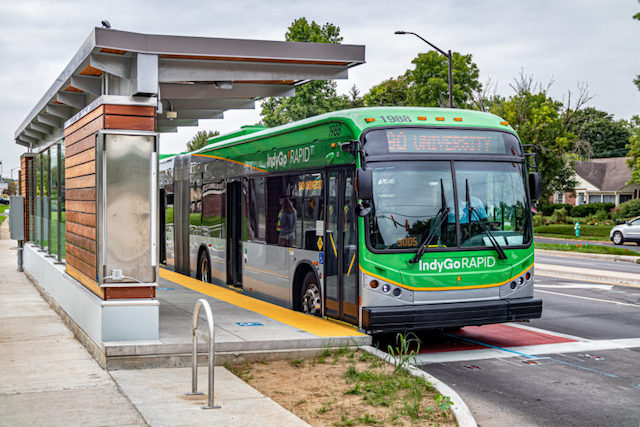Electric buses weigh more and put more stress on infrastructure than regular buses, as Indianapolis transit agency Indygo realized when it discovered that the streets it paved for its bus rapid transit lines were wearing out after less than three years of service. Now it is repaving those streets, which is causing problems for businesses and annoying residents along the routes.
An electric bus at one of Indygo’s bus rapid transit stops. Photo: Indygo.
The Indianapolis Department of Public Works had urged Indygo to use thicker pavement, but Indygo — which was already spending four years and too much money on a bus line that it could have started practically overnight at little cost — decided to save money on a part of the project that would be less visible to most people. After all, the point of the project was to please politicians with colorful buses and flashy bus stops, not to provide better transportation service.
Typically, Indygo refuses to accept the blame for the problem, instead saying it was due to “aging infrastructure” (yes, it was almost three years old). The agency also labels the millions of dollars that it is now having to spend “enhancements” instead of repairs due its incompetence.
A couple of years ago, anti-auto groups fretted that the extra weight of electric cars and light trucks were going to create problems for highways. But increasing the weight of a car from 3,000 to 5,000 pounds or a pickup from 5,000 to 8,000 pounds isn’t going to make much difference to roads designed to support 20,000 to 30,000 pound vehicles. However, increasing the weight of buses from 28,000 pounds (for a 40-foot Diesel bus) to 53,000 pounds (for the electric buses used by Indygo) can make a big difference.
The 2021 infrastructure bill included $5 billion for electric buses, but the authors of the bill obviously did not consider the side effects, including the need to repave roads to support those buses. Electric buses supposedly emit fewer greenhouse gases, but any savings could be wiped out by the extra greenhouse-gas cost of installing new pavement.
In Indygo’s case, the electric buses are purely for public relations. Indiana gets most of its electricity from burning fossil fuels and its electric power plants have some of the highest greenhouse gas emissions of any state in the country: 1,646 pounds per megawatt-hour in 2021, almost double the national average of 885.
As a result, Indygo electric buses use 36 percent more energy (because they are heavier) and emit 37 percent more greenhouse gases per vehicle-mile than Indygo’s Diesel buses. In 2019, Indygo’s bus rapid transit line succeeded in attracting 60 percent more riders on average (8.4 passenger-miles per vehicle-mile instead of 5.2) but carbon dioxide emissions per passenger-mile were still nearly as high: 418 grams vs. 495 for Diesel. If Indygo had used Diesel buses, they would have emitted only about 306 grams per passenger-mile — still more than the average car (197) or SUV (231), but a lot less than the electric buses.
This shouldn’t be a surprise because the Antiplanner predicted it back in 2016. What is a surprise is that Indygo failed to account for the effect of heavier electric buses on the infrastructure it built for the bus line, so now taxpayers are having to pay even more for a line that shouldn’t have cost that much in the first place.









EV Industry is making full size and larger suv and trucks. We all talked about weight issues EV would entail….. years ago anti auto coalitions lamented size of ever selling suv would wreak havoc on nations roads.
As anticancer notes with trains, railroad longevity is measured in tontons… a straightforward set of rail runs 1 billion tons before refurbishment and curved section of track 380 million tons…..
Highway with 2 to 4 ton vehicles and 50,000 a day handles 100 to 200 thousand tons a day. 700k 1.4 million a week or third billion tons a year… add trucks, haulers. Billion tons per mile per year………
Auto enthusiasts fought against weight penalties. Now our roads are cluttered with land yachts. EV cars carry 5…. weigh as much as SUVs that can carry 7.
Political discussion and average folks fight vehemently against reform and change, namely future predictions, then when the anticipated circumstances, the consequence of deferred responsibility, then the excuse is… “WE DIDNT SEE IT COMING”
*antiplanner. Fukin spellchecker
Unfortunately we this all the time. It’s not only less visible, but they’re kicking the problem can down the road.
RTD did this all over the place on their Fast tracks lines. Stations that were supposed to be built to handle a 1 in 100 year storm ( note, that is probability; can happen 2 years in a row ) were cut back to be built for 1 in 5 year storms.